p.126
p.132
p.138
p.144
p.150
p.156
p.162
p.169
p.175
Scaling Cellular Automaton Simulations of Short-Range Diffusion Processes
Abstract:
By applying the cellular automaton method the short-range diffusion processes in metals can be efficiently simulated. Several examples for the two-and three dimensional modeling of recrystallization and grain-coarsening are know at the literature. In some previous works, results have been performed concerning the two-dimensional, stochastic automatons of grain-coarsening, recrystallization and allotropic transformation. In order to use these simulations also in technological processes, it is necessary to scale the results reached by the simulation. The primary aspect of adapting the automaton in technological processes is the quick-operating simulation. The aim is to develop a most simplified, scalable cellular automaton by which scaling can be efficiently performed.
Info:
Periodical:
Pages:
150-155
Citation:
Online since:
November 2012
Authors:
Price:
Сopyright:
© 2013 Trans Tech Publications Ltd. All Rights Reserved
Share:
Citation:


